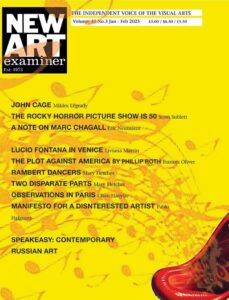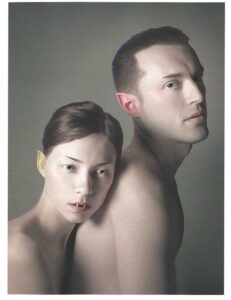
“Our heads are round so that thoughts can change direction.”
Thinking about ‘thinking’ is one way of paying attention. We can look, think, envision, gaze, fancy, ponder, dream, reflect, stare into the distance, imagine and/or remember things as they swim into our minds. It is doubtful any one of these ‘methods’ could result in a new thought. To be successful we need to be ‘outside’ ourselves so that we can observe ourselves thinking.
If it comes from ‘outside’ we are able to observe and speculate from some other discipline of thoughtfulness, rather than fall into mere habit taught from education or our culture. If achieved, the thought will be surprising and perhaps dangerous. How can we recognize a completely new thought and why does it happen, or need to happen? A new and often startling thought requires a new thinking process; it is not something that happens naturally.
The normally understood idea of thinking for rational human beings is that our brains are embedded in systems regulated by a hierarchy of knowledge. This poses such questions as: what system are we using? How is this hierarchy established? What is the rationale, if any? Is it ever possible to have a genuine original thought, even if we recognize usage of language systems as an exhaustion of meaning? Where can we find that thought, sui generis, that advent, opening up further thought into an unknown territory?
Francis Picabia, painter and Dadaist, once said, “our heads are round so that thoughts can change direction.”
In order to try and penetrate the idea of what this means and what thinking is, I want to equate thinking with drawing. In other words to look at what seeing and thinking means in terms of what our perception of the world is founded on, what happens when we see? and what do we see? More philosophically perhaps, through phenomenology, I want to investigate ideas of seeing and thinking that might bring to light a different kind of world.
The obvious authority on the subject of phenomenology is Maurice Merleau-Ponty’s book ‘The Primacy of Perception’, which mainly deals with painting and how we see. Edmund Husserl in ‘Ideas’ however, deals with thought: both these books interrelate.
James Turrell, the light artist, was once asked what influences guided him and his practice. He said:
“We are often unaware of how we perceive, and so we’re unaware of the fact that we have a strong part in creating what we behold”.
The world consists of height, width and length but also depth. In other words, as Herbert Read said, “thinking is experiencing the experience.” Cubism for example is an idea of extra dimensions, both sensuously and cognitively.
Hopefully my correlation of drawing and thinking will find fertile ground when it comes to thinking differently and being aware of William Blake’s observation that “we become what we behold.” Paying attention with intention to thought processes describes an approach where consciousness is not as we normally conceive it. Seeing what we see when drawing implies the notion of thought as contingent to drawing but the two are interwoven, coupled as one through decision and rejection, a process every drawer knows.
This process of thinking and drawing may produce something different if the thought process is developed in pursuit of the reality of the subject seen. That is, we begin to see more, the more we look, and the more we think. Thinking about thinking in itself, changes the look of the drawing. This happens, leading, possibly, to no end to thinking and drawing, and we find ourselves at the edge of impossibilities, where new territories happen that we had not been aware of at the beginning, and find ourselves beholding something strange, risky, seemingly crude or frightening, often elevating: the Turrell work practice.
Allen Ginsberg talked about selectivity of words as ‘un-selective’, but nonetheless as selective in the sense of caring about where those thoughts came from. Conversely, to make distinctions between different kinds of thought with a view to another’s mind is dangerous; as we know, taking somebody’s mind often results in stale thought. Paradoxically and importantly, Ginsberg also spoke of the “first thought is the best thought”. In this case this must depend fundamentally on where you’re coming from, what your philosophy of intentionality is, what is already a sedimentation in your mind, this all being part of your skill and purpose. Perhaps, with those first flashes you can be all encompassing: catching yourself at your first open thought.
 My concerns are with the poetics of drawing as a means to thinking. In the philosophy of aesthetics and the language of form, the ethical consideration is also of importance. What we make, what we do, rests on an assumption of ourselves as thinking beings. Artists and creative people generally set themselves within a crucial mode of action and thought that resembles a representation of themselves. When we are asked to explain ourselves what do we say? Whatever it is, we disclose ourselves, that is, who we are, where we come from, where we might be going. Ask yourself also why you do what you’re doing. These are crucial questions and relate directly to how you think. “Why do I do what I do?” should be asked of every contemporary artist and/or thinking being.
My concerns are with the poetics of drawing as a means to thinking. In the philosophy of aesthetics and the language of form, the ethical consideration is also of importance. What we make, what we do, rests on an assumption of ourselves as thinking beings. Artists and creative people generally set themselves within a crucial mode of action and thought that resembles a representation of themselves. When we are asked to explain ourselves what do we say? Whatever it is, we disclose ourselves, that is, who we are, where we come from, where we might be going. Ask yourself also why you do what you’re doing. These are crucial questions and relate directly to how you think. “Why do I do what I do?” should be asked of every contemporary artist and/or thinking being.
Physicality of the body is also important. How we root the body in relation to mindful thought that sets its sight on topologies from which the world is never the same; where that which we once knew and held as firm, is now seen as ruin. Thinking around the circularity of ideas and the search of the sensory within the sensibility of thinking we expand ourselves as points moving into directions of increasing dimensionality of distant levels and planes of perception (see drawing below). Sometimes we lose points or paths of directions; nevertheless points of endless beginnings can be found in thinking afresh.
This is where I need to emphasize the possibility that a reflexive, cognitive perception, one that is allied to an aesthetic. This can reach out not only through the boundary of convention but actually find, within the space of drawing and thinking, into another kind of dimensionality, one that is almost beyond comprehension and certainly outside worn out conventions. However, we often start with the known, but we hope that the known is always beyond or outside the last point, one that is based on ignorance of what we think we know.
Often it’s a matter of thinking without knowing, it’s a kind of thinking without thinking where we put ourselves outside the comprehensible. In that world we are then in a world of the extra-dimensional environment. This is when it becomes exciting.
Works of art are about thought processes. They are about ideas of the future. In this sense, form, in art and thought, is often revolutionary. The history of art evinces this. We should also find this in contemporary life and art. Hopeful futures in art are also hopeful ideas in life. This is where art and life come together.
In the social/political world today something crucial is taking place. I doubt at this moment whether physical protest is a viable action. Also, critical expositions are probably ceasing to be effective; written theses on alternative thought no longer are actually thought through into action. We are in need of a diametrical reconstruction and also deconstruction, if we use the word in its proper sense, from its base of philosophical knowledge of experience; a practice of enquiry into many layers of interpretation on the same object or thing. The question is, did philosophy go wrong in discussing consciousness, immanence and the transcendental? The artist is in the position of power in the sense of always remaining outside conventionality and the academic, as are individuals working from a different sense of education. Therefore we need to look to the artist/individual in education, to comprehend future constructs of thinking, as another way of seeing the world.
I’m talking about a change in perception of thinking itself through seeing. In looking at the world as we think we know it, to a new manner of difference in interpretation; to open an investigative approach concerning a more speculative approach to reality.
Look anew at the world as an object full of objects and include ourselves in this approach. Now we can begin to separate one object from another. Thus, a separation begins to happen within thought. Speculatively, objects are then seen as things ‘living’ outside thought, and also thinking as a thing in itself. As an artist, I would put this experience not only of consciousness, but also of a geometric dynamic into a dimensionality beyond three dimensions. This means that cognitive and intellectual approaches are necessary in thought and image.
Surprisingly perhaps, this approach has its own poeticism of expression in which the emotional is contained in intellectual ideas. Thankfully, artists and thinkers are in a position to strengthen an opposition to the process of commodification and corruption of culture.
The drawing (page 17) is an indication as a kind of speculation on how new thought can take place from other dimensions and further to distancing oneself from the world as known. The trick, as I have indicated, is to look at the world as a system of separate objects outside thinking. I don’t think this is fantasy but is a way of thinking when drawing. That is, drawing involves looking not once, but many times and the object changes in perception. Drawing, thought and life can thus be correlated in the sense that they all have to do with the way we see the world, and also in this sense the world can change, become different socially and politically, through art.
Ken Turner
Ken Turner was a lecturer at The Central School of Art and Design and St. Martins Art School. Lives in Cornwall: performance art, reading philosophy and painting being his main occupation. imaginativeeye.co.uk
Volume 30 number 6, July / August 2016 pp 17-19

